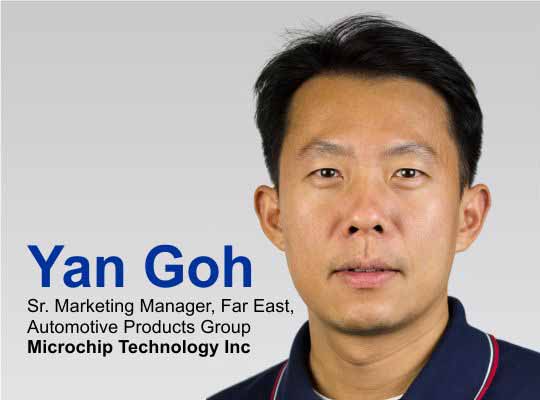Churning the latest breakthroughs, technology advancements and the critical role of more integrated-electronics in an electric vehicle Yan Goh, Sr. Marketing Manager, Far East, Automotive Products Group, Microchip Technology Inc gets alongside for an exclusive interview with Times Tech Buzz. Excerpts Below.
TimesTech Buzz: What technological breakthroughs has Microchip made in the application of electric vehicles? What are the competitive advantages of these technologies or products?
Yan Goh: Automotive electrification has been identified as one of the top trends that will increase semiconductor usage. Microchip Technology has been investing in next generation solutions targeting electric vehicles (EVs). The most important criteria in electric vehicles is getting the most mileage per charge. Our solutions are designed to cover a wide range of applications from electrical conversion, powertrain control and human machine interface seen in most EVs today. Critical requirements like low power consumption, integrated analogue peripherals to support high speed on chip data processing and high-speed interconnectivity are packed into our new microcontrollers. For example, our next generation microcontrollers pairing with our high voltage driver silicon carbide (SiC) MOSFET solutions, designed for DC-DC OBC module, consist of a dual core microcontroller setup coupled with software solutions to support a faster time to market, all while meeting all system requirement and functional safety aspects. When it comes to the human machine interface aspect, which we see in many EV dashboards, our solutions are developed with automotive applications in mind, enabling innovative lighting technology and various touch or 3D gesture-based input technology.
TimesTech Buzz: What are the advantages and disadvantages of the third generation compound semiconductor represented by SiC components in the application of electric vehicles? What is the current market demand and application prospect?
Yan Goh: In the EV market, the main factor deemed a critical challenge is range anxiety (miles/kW). Increasing vehicle range is clearly tied to making sure the highest efficiency is achieved to bring the battery power into the propulsion motor and to keep the overall vehicle weight down. In the area of electrical conversion, a challenge which many engineers face includes designing systems with less heat loss while meeting EMC-EMI performance in the rugged environment where the electronic controlling of the circuitry’s high frequency is necessary to maximize efficiency. More OEMs are introducing the 800V system as part of the weight reduction effort. In anticipation of the complexity brought by high voltage, high speed charging and high efficiency requirements, dedicated power controller electronics can be enabled by high voltage capable SiC MOSFET transistor diodes technology. These technologies are currently being embraced in the mainstream EV market today. Microchip Technology offers dedicated microcontrollers coupled with SiC MOSFETs and diodes which are capable of reaching over a 90 percent efficiency rating.
TimesTech Buzz: Nowadays, the degree of networking and intelligence in automobiles is increasing. This brings convenience to users, but also increases security risks, such as hacking into connected cars. What does Microchip think of this issue? Is there any solution to address security problems?
Yan Goh: Most of the next generation vehicle platforms are considering network based connectivity such as gigabit ethernet within the car. The V2X system with connectivity to the cloud through 4G or 5G networks are also being introduced. This technology is the backbone to support autonomous intelligence which requires optimum stability and highest security standards. As we have seen from various examples where cars are being hacked while driving, it’s a matter of life and death. In order to simplify and address this critical security need, dedicated hardware security module (HSM) enabled microcontrollers coupled with next generation high speed networking interfaces to support such usage modes are being used by automotive system architects. Microchip sees dedicated hardware security chips supporting features such as secure boot, node authentication and data encryption as critical elements which provide the automotive system designer with viable paths to address the OEM system requirements in a timely manner.
TimesTech Buzz: With the advent of the commercial era of 5G and AI, the global automotive industry is accelerating its transition to be intelligent and electrification. In this transformation, what opportunities and challenges does Microchip face? How does Microchip deal with these challenges?
Yan Goh: As explained earlier and as a semiconductor supplier, Microchip is addressing the new challenges and the new requirements set by automotive OEMs and Tier 1s in areas relating to higher processing power, higher levels of integration, higher power efficiency, high speed data connectivity, security needs and many more. These requirements were not seen previously in the internal combustion engine world where previously electronic requirements rarely changed. Nowadays, the speed of change to address new requirements from OEMs are coming in as fast as the consumer world! With Microchip Technology’s experience and wide product offerings in all market segments, we are able to react quickly to leverage our experiences with consumer and industrial market solutions and deliver innovative, cost effective, robust solutions for the automotive world. Our high-speed data connectivity offerings such as gigabit ethernet, gateways, automotive enabled PCIe switches, IoT security technology and capacitive enabling technologies are examples of such innovative solutions.
TimesTech Buzz: How do you see the market for electronics within the automotive industry going forward in India?
Yan Goh: Automotive electronics will continue to see a trend of increasing electronics content count. In India, one of the fastest growing automotive market in the world, we are seeing significant transformation where government and automotive OEMs are investing heavily. As describe earlier, almost all Indian automotive OEMs (4 wheeler and 2 wheeler) will continue their efforts and investment in electrification, hybrid technology, in vehicle human machine interface and autonomous technology. Riding the wave of homegrown India OEM design capability and improvements in product line up, this will spur the growth of the whole local automotive supplier ecosystems. This is the same playbook which developed markets went through in recent decades. Over time, as the knowledge base increases among local suppliers, we should see more homegrown electrical content used by local OEMs.















